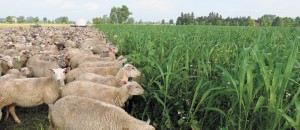GUELPH, Ont. — The art of agriculture or, for some, its spiritual essence, should be valued as much as the science, says a farmer from Ontario.
“We have to realize everything is interconnected and we cannot live in isolation,” Chris Boettcher told the Guelph Organic Conference Jan. 29.
“It may be that we’re entering the second age of enlightenment.”
Boettcher and his wife, Gabi, have lived what he describes as two different farming lifestyles.
They farmed conventionally in the 1980s, using the recommended crop inputs to grow corn, soybeans, wheat and canola. The Boettchers were successful, but chose another path because of what they feel was an environmental issue for one of their five children.
“I realized coincidences are seldom just coincidences.… We jumped into biodyanmics with both feet,” he said.
“And I asked myself, ‘why should I use chemicals labelled with skulls and crossed bones on it to produce food?’ ”
Biodynamics is a style of farming that emphasizes the relationships among all aspects of a farm, including the people. It looks at the whole rather than the parts, and an effort is made to build a farm’s resiliency from the inside out.
Boettcher said the concept goes back to Europe’s farming roots.
Observation and intuition were guiding lights for communities whose members worked together to feed themselves. The value of manure and green crops were widely recognized. In fact, in some jurisdictions, farmers were required to grow a green crop every third year.
Boettcher sees a renewed interest in this type of sustainable, self-reliant approach in Canada, whether it’s called organic, biodynamic or conventional.
However, Boettcher said resistance to the change is fierce.
“Conventional farming right now is very much in defence mode. Change is inevitable, but it often takes a crisis to make that change happen. Maybe we should be thankful to the Monsantos of this world for showing us how not to do it,” he said.
“We’ve degraded the environment, created dead zones in the Great Lakes and the Louisiana Basin in the Gulf of Mexico.… In a way, we’re wasting away our inheritance. We’re losing capital that should be for our children.”
Like organic farming, biodynamics looks to the powers of sun and soil biology as key elements for success. Boettcher said the sun’s energy is a free resource so why rely so extensively on digging up its ancient forms?
“There are more calories wasted with commercial nitrogen fertilizer than the diesel and all the other energy requirements for the rest of the farm,” he said.
Diverse rotations are embraced, and there’s an effort to keep the soil covered for as much of the year as possible through a combination of crops and cover crops.
Livestock are also integral to completing the nutrient cycle on the Boettcher farm. There are 200 milking goats owned by two sons and 800 ewes and lambs in the summer.
Temporary fencing helps keep fields grazed and fertilized as well as cropped. Manure produced in winter is composted before being applied.
The Boettchers also use plant- and animal-derived biodynamic preparations to stimulate plant and soil biological functions. Guidelines govern how they’re prepared and applied, but the amounts are miniscule.
Timing is also important. It is determined by the solar cycles, but the ground being “fit” can at times take precedence.
This gives the system, which was developed by German scientist and philosopher Rudolf Steiner a mysterious air, but Boettcher is a believer.
“Biodynamics didn’t make sense to me in the beginning, but it was more attractive than organics,” he said.
“Steiner said, ‘don’t take me as a guru. Don’t believe me. Think with me and then you can come to the same conclusions that I came to.’ ”
Gabi said the scientific community has scrutinized Steiner’s methodologies.
In 2000, a study published in Biological Agriculture and Horticulture by U.S researchers found that preparations sped the compost process and resulted in significantly higher nitrate content.
According to a 2012 study in Environmental Science and Pollution Research that examined a biodynamic cow horn preparation: “Our results provide, for the first time, a scientific characterization of an essential product in biodynamic agriculture … potentially conducive to plant growth stimulation.”
The Boettchers farm more than 600 acres with both biodynamic and organic certification. Boettcher said he’s been pleased with his income since making the switch.
However, it’s about more than the money, however. Neighbours have commented on the farm’s intrinsic beauty.
Over the past two years, it has become a preferred site for a honey producer.
“I want to put soul back into the soil. This is about making a life and making a living…. There’s more out there then what we can weigh and count. We need to put our intention into the land,” he said.
“All five of our children are looking to farm.”
The family emphasizes quality over quality, but Boettcher said most of their yields are “on par” with county averages.

